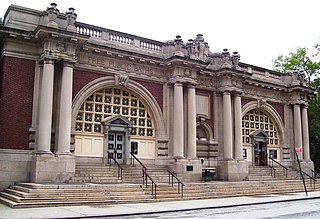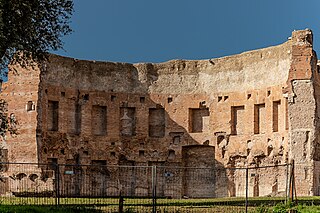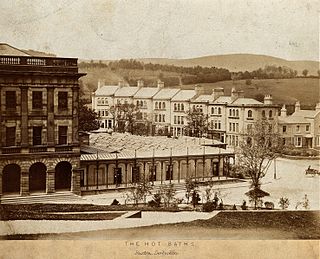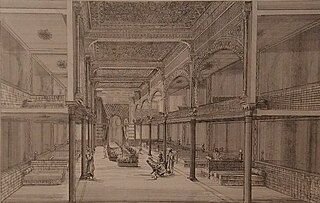
A sauna is a room or building designed as a place to experience dry or wet heat sessions, or an establishment with one or more of these facilities. The steam and high heat make the bathers perspire. A thermometer in a sauna is typically used to measure temperature; a hygrometer can be used to measure levels of humidity or steam. Infrared therapy is often referred to as a type of sauna, but according to the Finnish sauna organizations, infrared is not a sauna.

The Finnish sauna is a substantial part of Finnish and Estonian culture.

A bathroom is a room in which people wash their bodies or parts of their bodies. It can contain one or more of the following plumbing fixtures: a shower, a bathtub, a bidet, and a sink. The inclusion of a toilet is common. There are also specific toilet rooms, only containing a toilet, which in North American English tend to be called "bathrooms", "powder rooms" or "washrooms", as euphemisms to conceal their actual purpose, while they in British and Irish English are known as just "toilets" or possibly "cloakrooms" - but also as "lavatories" when they are public.

Sentō (銭湯) is a type of Japanese communal bathhouse where customers pay for entrance. Traditionally these bathhouses have been quite utilitarian, with a tall barrier separating the sexes within one large room, a minimum of lined-up faucets on both sides, and a single large bath for the already washed bathers to sit in among others. Since the second half of the 20th century, these communal bathhouses have been decreasing in numbers as more and more Japanese residences now have baths. Some Japanese find social importance in going to public baths, out of the theory that physical proximity/intimacy brings emotional intimacy, which is termed skinship in pseudo-English Japanese. Others go to a sentō because they live in a small housing facility without a private bath or to enjoy bathing in a spacious room and to relax in saunas or jet baths that often accompany new or renovated sentōs.

Solar thermal energy (STE) is a form of energy and a technology for harnessing solar energy to generate thermal energy for use in industry, and in the residential and commercial sectors. Solar thermal collectors are classified by the United States Energy Information Administration as low-, medium-, or high-temperature collectors. Low-temperature collectors are generally unglazed and used to heat swimming pools or to heat ventilation air. Medium-temperature collectors are also usually flat plates but are used for heating water or air for residential and commercial use.

In ancient Rome, thermae and balneae were facilities for bathing. Thermae usually refers to the large imperial bath complexes, while balneae were smaller-scale facilities, public or private, that existed in great numbers throughout Rome.

Bathing is the act of washing the body, usually with water, or the immersion of the body in water. It may be for personal hygiene, religious ritual or therapeutic purposes. By analogy, especially as a recreational activity, the term is also applied to sun bathing and sea bathing.

Public baths originated when most people in population centers did not have access to private bathing facilities. Though termed "public", they have often been restricted according to gender, religious affiliation, personal membership, and other criteria.

A spa is a location where mineral-rich spring water is used to give medicinal baths. Spa towns or spa resorts typically offer various health treatments, which are also known as balneotherapy. The belief in the curative powers of mineral waters goes back to prehistoric times. Such practices have been popular worldwide, but are especially widespread in Europe and Japan. Day spas and medspas are also quite popular, and offer various personal care treatments.

The banya is a traditional Russian steam bath that utilizes a wood stove. It is a significant part of Russian culture, and is typically conducted in a small room or building designed for dry or wet heat sessions. The high heat and steam cause bathers to perspire, and traditionally, genders were segregated in the banya, with separate rooms for each sex.
Renewable heat is an application of renewable energy referring to the generation of heat from renewable sources; for example, feeding radiators with water warmed by focused solar radiation rather than by a fossil fuel boiler. Renewable heat technologies include renewable biofuels, solar heating, geothermal heating, heat pumps and heat exchangers. Insulation is almost always an important factor in how renewable heating is implemented.

Bathing played a major part in ancient Roman culture and society. It was one of the most common daily activities and was practised across a wide variety of social classes. Though many contemporary cultures see bathing as a very private activity conducted in the home, bathing in Rome was a communal activity. While the extremely wealthy could afford bathing facilities in their homes, private baths were very uncommon, and most people bathed in the communal baths (thermae). In some ways, these resembled modern-day destination spas as there were facilities for a variety of activities from exercising to sunbathing to swimming and massage.

Water heat recycling is the use of a heat exchanger to recover energy and reuse heat from drain water from various activities such as dish-washing, clothes washing and especially showers. The technology is used to reduce primary energy consumption for water heating.

A steam bath is a steam-filled room for the purpose of relaxation and cleansing. It has a long history, going back to Greek and Roman times.

Heat traps are valves or loops of pipe on the cold water inlet and hot water outlet of water heaters. The heat traps allow cold water to flow into the water heater tank, but prevent unwanted convection and heated water to flow out of the tank. Newer water heaters have built-in heat traps.

The Lukács Thermal Bath is a historic indoor/outdoor thermal bath spa in Budapest, Hungary, heated by natural hot springs. All pools and four saunas can be used by all guests except for the optional area of the sauna world, which contains five more saunas, ice cooling pool, igloo and heated roman bench.
Finnila's Finnish Baths—a.k.a. Finnila's—was a Finnish bathhouse and a health club in San Francisco, California. It served the general public from circa 1910 to September, 2000. Finnila's was located in the Castro District of San Francisco for its first 75 years.

The Buxton Baths using natural thermal spring water are in Buxton, Derbyshire, England. The baths date back to Roman times and were the basis for developing Buxton as a Georgian and Victorian spa town. The present buildings of the Thermal Baths and the Natural Mineral Baths were opened in the 1850s. They are positioned either side of the Buxton Crescent at the foot of The Slopes in the town's Central Conservation Area. They are both Grade II listed buildings designed by Henry Currey, architect for the 7th Duke of Devonshire.

The Victorian Turkish bath is a type of bath in which the bather sweats freely in hot dry air, is then washed, often massaged, and has a cold wash or shower. It can also mean, especially when used in the plural, an establishment where such a bath is available.

















